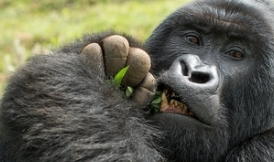Bwindi’s Mountain Gorillas
Uganda’s Bwindi Impenetrable Forest, basically restricted in Bwindi Impenetrable National park , comprises a large ancient forest at altitudes with a leg on each side of from 1,160 to 2607 metres .The impenetrable forest also known as the ‘place of darkness’, is situated in the southwestern Uganda on the edge of western arm of the Great Rift Valley ,about 25 kilometers north of the Virunga volcanoes.

Solitary of the the majority physically diverse areas on globe, where half the world’s population of the highly endangered Mountain Gorilla live (approximately 400) and which has led to the gorilla safaris which can also be combined with other safaris like birding safari for those interested in birding, flying safaris mostly those who do not want to use road transport, chimpanzee safaris,cultural safaris and many more. The park is also a sanctuary for colobus monkeys and chimpanzees. Having one of the richest ecosystems in Africa it provides habitat for some 120 species of mammals, 346 species of birds ,202 species of butterflies ,163 species of trees, 100 species of ferns,27 species of frogs, chameleons geckos and many others.
Mountain Gorilla Families of Uganda, The Habituated Gorilla Groups
, Buhoma Area of Bwindi Impenetrable Forest
- Mubare Group: this Mubare group (also called the M-Group) – was the extremely first group to essentially be habituated for tracking by tourists. The habituation started in 1991 and this group acknowledged its very first tracking visitors in 1993. Mubare group is actually named after the dazzling Mubare Hills in which this group was discovered.
- Habinyanja Group: This Habinyanja Group was in 1997 habituated for tracking and received tourists in the year 1999. In the initiate it was a vast group, though a family was divided from it named the Rushegura Group. These two groups zigzag each other now and again and co-exist peacefully.
- Rushegura Group: This Rushegura Group was in 2000 habituated for tracking and received tourists in the year 2002. It is a huge group within the Buhoma area of Bwindi Forest.
Ruhija region of Bwindi Impenetrable Forest – habitat of the Bitukura Gorilla group
- Bitukura Group: This Bitukura Group is amongst of the newest groups in Bwindi Forest- it originate and roams the luxuriant forest within the Ruhija area.
Rushaga region of Bwindi Forest – territory of the Nshongi Group as well as the Mishaya Gorilla Family
- Mishaya Group: following a family dispute- the Mishaya Gorilla family tear from the then biggest Gorilla Group in Bwindi Forest – the Nshongi Gorilla Family – which two still live within the Rushaga region in Southern Bwindi Forest.
- Nshongi Group: This currently is the biggest habituated gorilla family in Uganda with 25 members , at the opening of the group for visitors after Habituation it comprised of 25, and 10 left to form another family called the Mishaya Group.
Nkuringo Region of Bwindi Forest – which is among the more physically challenging although rewarding regions in the of forest to enjoy Gorilla Tracking – habitat to the Nkuringo Gorilla Family
- Nkuringo Group: The accommodation facilities found at Nkuringo – offer a awesome worth the cost of the gorilla-permits- this is among of the most challenging hikes in Uganda – although certainly meaningful- as it is the most lovely. The Group comprises of 19 members and is a favorite to people who have tracked over one group. Trekking permits available for each group amount to 8 day, enabling a total of 32 visitors to trek for these charming primates every day within Uganda.
The entire adult males are known as silverbacks ,but it doesn’t pending they reach sexual maturity ,about 12 years of age, that lumber of a grey or silver- colored hair develops on their backs.Gorillas are extremely communal and group sizes differ from five to thirty. With standard of ten individuals. A emblematic group comprises of one silver back, the group’s acknowledged leader ,one or two black backs who act as sentries ,three to six juveniles and infants .The dominant ‘silverback’ usually determines the whereabouts of the group, leading it to suitable feeding sites through out the year and like most men, he enjoys being the centre of awareness during the daily rest sessions.
The Mountain Gorilla has no mating season so babies are born through out the year, a newborn weighs about1.8kg and if male, can go on to weigh up to 204 -227kg and .During the early months the young are in constant physical contact with their mother riding on her back or being cradied in her arms .At between 4-5months old it will begin to walk and a couple of months later it will start experimenting with plants, stuffing little first of vegetation into its mouth. The weaning of the infants usually takes place at around 3 years ,but it’s not un common for juvenilies to remain with their mother for years to come.
Gorilla trekking is an unbelievable experience, but one not to be under predictable it’s not a walk in the park, but as a substitute to a trek within an impenetrable forest .You will be striding up hills ,down slopes ,over branches and possibly a cross streams .But then this trek is quite distinct any other .The day starts with you being guided by your ranger who then assembles a party of trackers and guides-men who will escort you and your group for the trek. Now here’s a tip ,you will need a excellent pair of walking boots as the going can be wet underfoot and slippery and spiky vegetation can poke and pick at your ankles.
The distance end to end of the trek can be any thing from half an hour to six hours-this depends on where the family unit of gorillas exhausted the previous night and how distant they may have moved that morning .Your trackers will lead the way and once away from the noticeable trail it’s a case of bending and folding yourself under branches whilst of swatting vines and leaves from a cross your face .It’s at this point you start to question your sanity – you are halfway up a mountain and trekking for something hairy that you have seen on a television screen hundred s of miles away from your present location. But it’s then that you hear a low grunting sound, followed by another grunt and your guide turns his head and tells you to keep quit and to move forward slowly.
when the canopy of the vegetation is detached ,it is like a shade being pulled from a cross a stage. There before you sit your family of mountain gorillas The juveniles play – rolling and shoving each other a cross the forest. Floor while the older females sit peacefully chewing on sticks of bamboo and if you are lucky you may spot baby nesting in its mother’s arms. There has to be more than 5 metres far way between you and the gorillas, but if the roles are reversed it can be tricky to limit these interesting creatures from approaching you.
At the same time as you have been fascinated by his family ,the large dominant silverback will have been watching you often sitting silently at the back of his group. When the time comes he will push himself forward and knuckle walk proudly amongst his family, his absolute size and size casting a shade of respect .He may pose for a short time, flip at one of the juvenilies absently, or collide to the forest floor, but there’s no questioning his authority and you will feel it yourself- a tingle going down your spine.
Past your hour’s screening your guide will tap you on the shoulder and suggest that you back slowly away .As you head towards the camp your time spent in the presence of these magnificent gorillas will keep you questioning how familiar they are ,very familiar in fact and that there’s a little bit of them hidden in us all

